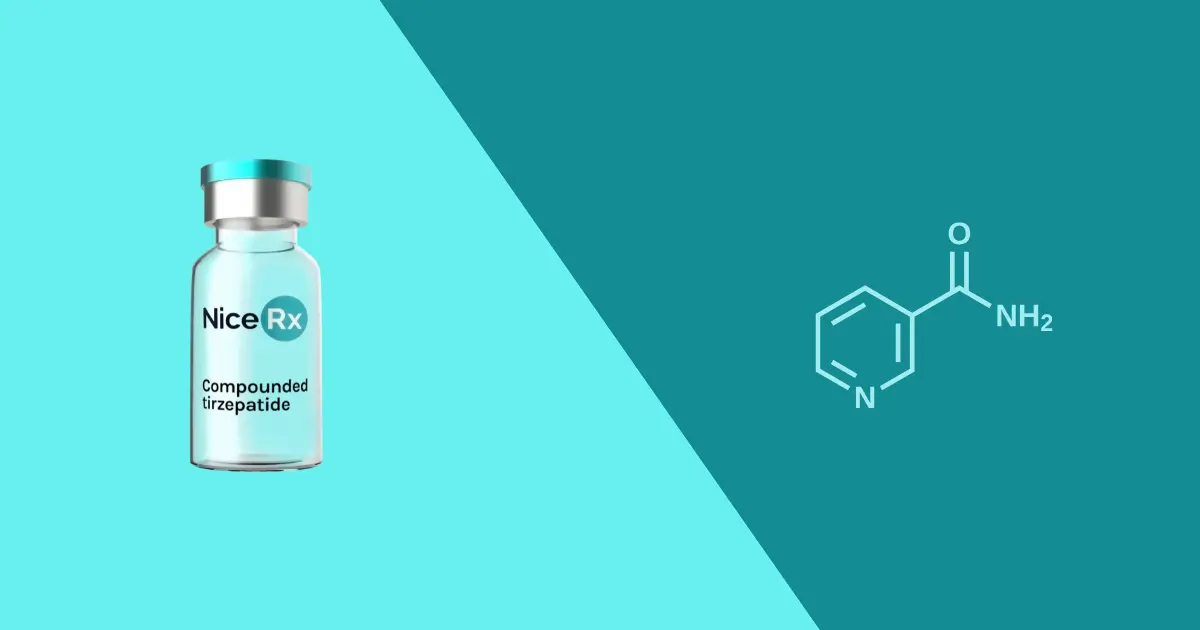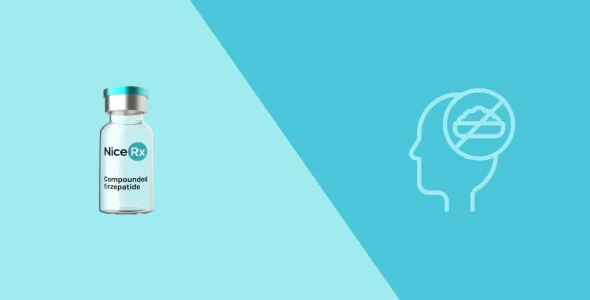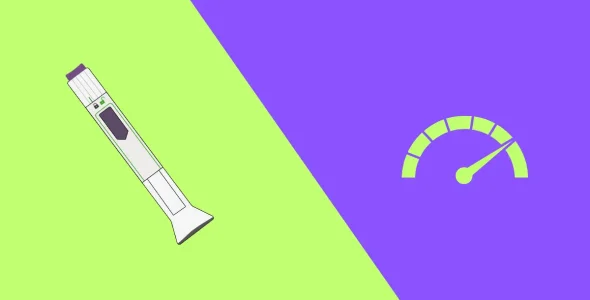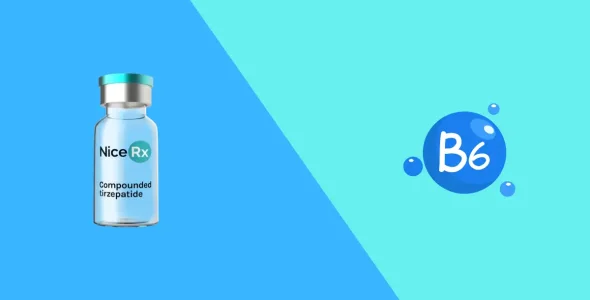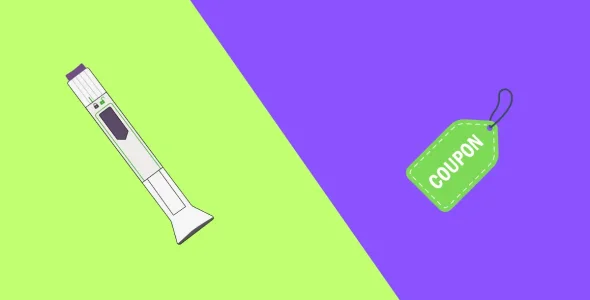Tirzepatide and niacinamide: A comprehensive guide for weight loss
What if you could enhance the already powerful effects of a leading weight loss medication? The latest trend in peptide therapy combines tirzepatide with niacinamide, promising a more supported and effective journey.
Key highlights
- Tirzepatide is the first dual GLP-1/GIP receptor agonist that offers stronger appetite suppression, improved glycemic control, and provides significantly greater weight loss than single receptor agonists such as semaglutide, liraglutide, and dulaglutide.
- Niacinamide (Vitamin B3) supports cellular energy production, improves fat metabolism, and may complement the metabolic effects of tirzepatide.
- Compounded tirzepatide with niacinamide is not FDA-approved and should only be used when prescribed by a licensed healthcare provider.
- Safe use requires a valid prescription, gradual dose escalation, and guidance from your healthcare provider to manage gastrointestinal side effects.
- Compounded tirzepatide is typically not covered by insurance.
GLP-1 medications are becoming increasingly popular for their weight loss results and gaining significant attention across social media platforms like Facebook, Twitter, and TikTok. One of the most effective medications for weight loss is tirzepatide, which is the active ingredient of Mounjaro and Zepbound.
Unlike older GLP-1 medications that target only one hormone, tirzepatide is the first dual GLP-1 (glucagon-like peptide 1) and GIP receptor agonist that offers greater benefits, including stronger appetite suppression, deeper metabolic changes, and more significant weight loss.
You might have seen compounded tirzepatide with niacinamide (B3) online and wondered what it is. This is a compounded version of tirzepatide combined with niacinamide (Vitamin B3). It is becoming increasingly popular as some clinics and pharmacies claim that it may improve tolerance and effectiveness. However, it is important to note that compounded products are not approved by the FDA for their safety, quality, or efficacy, and should only be used when prescribed by a qualified healthcare provider.
This comprehensive article explains what compounded tirzepatide with vitamin B3 is, why it’s being used, and what you should know about its safety. Moreover, we will also discuss the metabolic theory behind niacinamide and why it’s being added to this compound.
What is tirzepatide?
Tirzepatide is an effective medication approved by the U.S. Food and Drug Administration (FDA) for treating type 2 diabetes and obesity, and obstructive sleep apnea.
Mechanisms of action
- Tirzepatide is a dual GLP-1/GIP receptor agonist that occupies GLP-1 and GIP receptors simultaneously to improve metabolic health.
- This medication mimics the activity of the GLP-1 hormone to help regulate appetite and blood sugar levels. It works by reducing appetite, slowing stomach emptying, decreasing food cravings, and helping you feel full for longer.
- This medication also mimics the activity of glucose-dependent insulinotropic polypeptide (GIP).
- It works by improving fat metabolism, increasing insulin sensitivity, and providing significantly greater weight loss compared to single-agonist peptides such as semaglutide (Ozempic and Wegovy), liraglutide, and dulaglutide.
- Tirzepatide burns stored fat in the body for energy production while stabilizing blood glucose levels.
Tirzepatide is FDA-approved under the following brand names:
- Mounjaro (approved for type 2 diabetes mellitus)
- Zepbound (approved for chronic weight management and treatment of moderate to severe obstructive sleep apnea)
Tirzepatide’s proven efficacy
Tirzepatide is more effective than single-acting GLP-1 medications in achieving significant weight loss. In the SURMOUNT-1 clinical trial, individuals with overweight/obesity without diabetes taking tirzepatide (5 mg, 10 mg, and 15 mg once weekly) lost 16%, 21.4%, and 22.5% of body weight, respectively, after 72 weeks.
Tirzepatide lowers blood sugar levels and promotes glycemic control more effectively than single GLP-1 receptor agonists such as semaglutide. In a clinical study, after 40 weeks of treatment, tirzepatide showed greater reductions in HbA1c compared with semaglutide. The mean HbA1c reductions from baseline were 2.01% with 5 mg, 2.24% with 10 mg, and 2.30% with 15 mg of tirzepatide, compared with 1.86% for semaglutide.
Tirzepatide also improves cardiometabolic health by lowering HbA1c and body weight. This medication reduces blood pressure, decreases cholesterol (LDL) and triglycerides, and raises HDL cholesterol.
What is niacinamide?
Niacinamide, also called nicotinamide, is a form of vitamin B3. It plays an essential role in cellular energy metabolism (ATP), DNA repair, and skin health. The inclusion of vitamin B3 in supplements or formulations is based on a metabolic theory of enhancement, which means it supports the production of cellular energy (ATP) and other metabolic processes rather than being primarily used for nausea (unlike niacin).
Niacinamide is a form of vitamin B3 that does not cause flushing, unlike niacin, which can cause temporary redness and increased skin temperature at higher doses.
Niacinamide plays an important role in our body, including:
- Skin health: It is frequently used in topical skin care products for its anti-inflammatory and barrier-strengthening properties.
- Cellular energy metabolism: Niacinamide acts as a precursor for NADH and NADPH, which are the essential coenzymes for the production of energy.
- DNA repair: It also supports DNA repair and contributes to healthy cell functions.
Niacinamide acts as a precursor for NAD+ (nicotinamide adenine dinucleotide) and NADP+ (nicotinamide adenine dinucleotide phosphate), which are the essential coenzymes involved in energy production (ATP). These molecules play an important role in the conversion of food and stored fat into usable energy within the mitochondria, the “power house” of the cell.
During weight loss with tirzepatide, the body’s energy demand increases due to enhanced fat breakdown and elevated metabolic activity. Niacinamide (B3) helps mitochondria (the powerhouse of the cell) function more efficiently and prevent metabolic fatigue associated with calorie restriction.
Niacinamide also plays an important role in lipid metabolism and helps improve insulin sensitivity. When combined with the tirzepatide, it may provide a synergistic effect. Tirzepatide helps regulate appetite and blood sugar control, while niacinamide optimizes the cellular machinery to utilize fat and glucose more efficiently.
Cosmetic and body benefits of niacinamide
Niacinamide offers multiple benefits for skin and overall body health.
Niacinamide supports skin health by producing keratin and ceramide, which are the key components of the skin barrier. This helps strengthen the skin, reduce inflammation and redness, making it a popular ingredient in skin care products.
Your neurons and digestive system are also highly energy-dependent. During weight loss, reduced energy levels can impact both nerve and digestive health. Niacinamide supports energy production, nerve functions, and neurotransmitter synthesis. It also improves nervous system functions and digestive health.
Niacinamide (vitamin B3) helps maintain healthy cholesterol and triglyceride levels by supporting fat metabolism. It reduces LDL and triglyceride levels, increases HDL, and promotes overall cardiovascular health.
Why combine tirzepatide with niacinamide?
Tirzepatide is combined with niacinamide as it may support overall wellness, enhance metabolism, and mitigate the risk of common side effects. The combination of tirzepatide with niacinamide is not made by the original manufacturer (Eli Lilly). Instead, it is manufactured by the specialized 503A compounding pharmacies or 503B outsourcing facilities. While the compounding practice is regulated, this combination is not FDA-approved, and no clinical trials have been conducted to assess its efficacy.
In comparison, FDA-approved tirzepatide (Mounjaro and Zepbound) is manufactured by Eli Lilly and produced under strict FDA regulations. Brand-name tirzepatide has been tested for its safety, efficacy, and quality in clinical trials and is available in fixed doses only.
Enhanced metabolic support
Vitamin B3 plays a key role in converting food into cellular energy (ATP). When combined with tirzepatide, it may help boost the body’s ability to use fat and glucose efficiently, complementing the metabolic effects of tirzepatide.
Mitigating side effects
Many pharmacies and clinics claim that niacinamide may help reduce certain gastrointestinal side effects of tirzepatide, such as nausea. However, this is a theoretical benefit which has not been validated by large-scale clinical studies, so it should be considered a potential rather than guaranteed effect.
Supporting overall wellness
Niacinamide helps support your body’s overall health and wellness during your weight loss journey. It provides essential nutrients that aid energy production, boost metabolism, and general well-being while your body adapts to changes in weight and nutrition.
Potential benefits of tirzepatide with niacinamide
Tirzepatide with niacinamide is a new custom-made treatment used to support metabolism and overall health. As previously mentioned, there are no clinical trials to substantiate the benefits. The potential benefits of tirzepatide may include the following:
Significant and sustained weight loss
Tirzepatide is a dual GLP-1/GIP receptor agonist that helps significantly reduce body weight by enhancing insulin secretion, lowering glucagon levels, and delaying gastric emptying, which contribute to reduced calorie intake and weight loss. During weight loss, you may feel fatigued or sluggish due to lower energy levels. Niacinamide helps support the production of cellular energy, which may aid in maintaining muscle mass and steady energy throughout the day.
Improved blood sugar (glucose) control
Tirzepatide helps lower both fasting and post-meal blood sugar levels through glucose-dependent mechanisms, which means it works mainly when blood sugar levels are high. This medication helps increase insulin secretion only when glucose levels are elevated, reducing the risk of hypoglycemia (low blood sugar levels). At the same time, it reduces the release of glucagon, a hormone that normally raises blood sugar levels. Tirzepatide also improves insulin sensitivity and slows gastric emptying, helping control rapid spikes in blood sugar after meals.
Niacinamide may also support this action by protecting pancreatic beta cells, enhancing insulin sensitivity, and promoting efficient glucose metabolism through its role in energy production. Together, they may help the body control blood sugar more effectively.
Reduced appetite and cravings
Tirzepatide targets appetite regulation centers in your brain to decrease hunger and cravings. Niacinamide also helps stabilize blood sugar levels, which may also reduce food cravings and improve energy metabolism.
Potential for improved satiety (feeling full)
Tirzepatide helps to improve satiety, or the feeling of fullness, by slowing down the movement of food through the stomach. It decreases peristaltic movements (wave-like contractions) in the digestive tract and delays gastric emptying. Therefore, food stays in your stomach for longer. As a result, it gives a feeling of satiety or fullness, which leads to reduced appetite and lower overall calorie intake. This effect contributes to better blood sugar control and weight loss.
Niacinamide helps by supporting energy metabolism and keeping blood sugar stable, which also reduces hunger and cravings. A combination of tirzepatide and niacinamide helps control appetite and support healthy weight management.
The convenience and potential
Compounded medications that combine tirzepatide with other ingredients, such as niacinamide, in one preparation rather than taking them separately. This may help increase patient adherence and reduce the risk of injection site reactions when taking multiple injections.
Important considerations and potential side effects
Tirzepatide with niacinamide may offer many benefits, but can cause side effects. Understanding these risks and using them under medical supervision is essential for safe and effective treatment
Tirzepatide-related side effects
Tirzepatide can cause gastrointestinal-related side effects, usually at the start of treatment or during the dose escalation phase. These include:
- Nausea
- Vomiting
- Diarrhea
- Constipation
- Stomach discomfort
- Abdominal pain
- Decreased appetite
These side effects are usually mild and temporary and subside on their own. However, in rare cases, more serious side effects can occur, such as:
- Pancreatitis (inflammation of the pancreas)
- Gallstones or cholecystitis (inflammation of the gall bladder)
Niacinamide-related side effects
Niacinamide is generally well-tolerated when taken at a normal dosage. However, high doses may cause mild symptoms such as:
- Nausea
- Dizziness
- Skin rash
These side effects are also minor and subside over time when the dose is adjusted or the body adapts.
The critical importance of medical supervision
Tirzepatide is a potent medication, not a causal supplement. Therefore, it is important to get a prescription from a licensed healthcare provider who can assess your eligibility, monitor your progress and help you manage the potential side effects associated with the medication.
Compounding is not FDA-approved
It is important to understand that tirzepatide/niacinamide injection is a compounded drug and has not undergone any clinical trials required for FDA approval.
The active ingredient (tirzepatide base) is typically sourced from FDA-registered suppliers. The combination with niacinamide lacks clinical validation for its safety, stability, or long-term effectiveness.
When not compounded properly by a licensed compounding pharmacy, the addition of an additive such as niacinamide may affect the stability of the peptide, potentially reducing its potency and overall effectiveness over time.
Compounded drugs should only be used when prescribed by a licensed healthcare provider and purchased from a licensed 503A compounding pharmacy.
Contraindications
Tirzepatide should not be used by individuals with certain medical conditions due to potential health risks:
- People with a personal or family history of medullary thyroid carcinoma (MTC) should not use tirzepatide, because the medication may increase the risk of tumor growth in the thyroid gland.
- Tirzepatide is contraindicated in patients with a history of multiple endocrine neoplasia syndrome type 2 (MEN 2).
- Individuals with severe gastrointestinal problems such as gastroparesis (delayed stomach emptying) or a history of severe pancreatitis (inflammation of the pancreas) should not use tirzepatide, as it can aggravate these conditions.
- Tirzepatide should not be used in pregnancy or while breastfeeding. It is important to stop the medicine at least one month before conception.
Manging interactions
Tirzepatide may interact with other medications, which can affect their effectiveness or increase the risk of side effects. Always inform your healthcare provider about any other medications or supplements you are taking to ensure safe and effective treatment.
Tirzepatide can reduce the effectiveness of oral birth control pills by slowing the stomach emptying or by decreasing the absorption of pills. Therefore, speak to your doctor about using an alternative such as an IUD while using tirzepatide.
When tirzepatide is used with other glucose-lowering drugs such as insulin or sulfonylurea, the medication may increase the risk of hypoglycemia (low blood sugar level). Therefore, monitor your blood sugar levels regularly and consult with your healthcare provider for dose adjustment if you experience hypoglycemia.
How to use tirzepatide niacinamide safely
Tirzepatide with niacinamide should only be used according to the guidance of your healthcare provider. It is essential to follow your healthcare provider’s instructions for dosing, administration, and storage to ensure safety and effectiveness.
Get a prescription
Before starting tirzepatide with niacinamide, it is essential to consult with a licensed healthcare provider. Your healthcare provider will assess your medical history, current medications, side effect profile, and overall health to determine whether this treatment is appropriate for you. Therefore, a valid prescription from a licensed healthcare provider is necessary to ensure you receive the correct and appropriate dose.
Find a legitimate compounding pharmacy
Always obtain the medication from a reputable, FDA-registered compounding pharmacy. Avoid purchasing compounded medications from unverified or online sources, as they may carry risks of contamination or dosing errors.
Dosage and administration
Tirzepatide is typically started at a low dose (2.5 mg). Afterwards, your doctor increases the dosage gradually over several months to the target therapeutic dose to manage gastrointestinal side effects such as nausea, vomiting, diarrhea, constipation, and stomach discomfort.
The standard tirzepatide dosing schedule is as follows:
- Start with the lowest tirzepatide dose, 2.5 mg once weekly for the first 4 weeks.
- Increase the dose to 5 mg once a week for the next 4 weeks if tolerated.
- Your healthcare provider may continue increasing the dose by 2.5 mg every 4 weeks until reaching the target therapeutic dose (commonly 10–15 mg weekly).
Dosing can vary, as it’s typically personalized by your healthcare provider according to your personal needs. The dosing should always be determined by your doctor. Do not self-prescribe or adjust your dose without medical guidance. Using tirzepatide improperly can lead to adverse reactions or reduced effectiveness.
Tirzepatide with niacinamide is typically administered as a once-weekly subcutaneous injection (under the skin). Common injection sites include the abdomen, thigh, or upper arm. It is also important to rotate the injection site each week to prevent irritation or tissue damage.
Frequently asked questions
Is compounded tirzepatide with niacinamide legal?
Compounded tirzepatide with niacinamide is only legal in certain conditions, such as during a drug shortage or when the patient needs a custom formulation that is not commercially available.
Is tirzepatide + niacinamide FDA-approved?
No, tirzepatide + niacinamide is not FDA-approved. However, tirzepatide alone is FDA-approved under the brand names of Mounjaro and Zepbound. The combination of tirzepatide with niacinamide is a compounded formulation, which means it has not been reviewed or approved by the FDA for its safety or effectiveness.
Does niacinamide reduce side effects or increase weight loss?
No clinical trials exist that show that niacinamide reduces tirzepatide-associated side effects or enhances weight loss.
Is it safe?
When prescribed and monitored by a licensed healthcare professional and sourced from a reputable and legitimate compounding pharmacy, the use of tirzepatide with niacinamide is considered safe in common practice. It may carry risks associated with compounding, such as variable quality and risk of contamination and dosing errors. You should only purchase the medication with a prescription from a licensed 503A compounding pharmacy.
How much does it cost?
The cost of compounded tirzepatide with niacinamide generally ranges between $300 $600 per month, depending on the dose and provider.
Can insurance cover compounded tirzepatide?
No, compounded tirzepatide is not covered by insurance because this medication is custom-made according to the patient’s need by compounding pharmacies and is not approved by the FDA. Therefore, patients usually pay out-of-pocket for compounded formulations.
Can I take it if I don’t have diabetes?
Yes, it can be used for chronic weight management in individuals without diabetes. However, a doctor must evaluate your BMI and medical history to determine if it is appropriate and safe for you.
What’s the difference between this and semaglutide (Ozempic/Wegovy)?
Tirzepatide is a dual-agonist, targeting both GLP-1 and GIP receptors, whereas semaglutide is a single-agonist that targets only GLP-1. Clinical trials suggest that brand-name tirzepatide can produce slightly greater weight loss on average compared to semaglutide.
Conclusion: Is tirzepatide and niacinamide right for you?
Tirzepatide with niacinamide is a new, powerful tool for weight loss and metabolic health. Tirzepatide works as a dual receptor agonist that helps reduce appetite, delay gastric emptying, and support long-term weight loss. Niacinamide supports cellular energy and overall metabolic health, potentially enhancing the effects of tirzepatide.
However, compounded tirzepatide with niacinamide is not FDA-approved for its safety, quality, and effectiveness. This medication should only be used when prescribed and monitored by a qualified healthcare provider and sourced from a reputable and licensed compounding pharmacy. If you want to start tirzepatide with niacinamide, consult your healthcare professional to discuss your current medical condition, side effect risks, the pros and cons of this combination, and whether it is right for you.
